In India, the Personal Protective Equipment (PPE) industry has grown to an estimated Rs 10,000 crore industry from scratch from the past three months. The COVID-19 pandemic has brought this industry under the untimely limelight. PPE includes hand gloves, face masks, protective clothing, etc.
Before COVID-19 could invade India, specific facts highlight that this industry was indicating a dying demand year-on-year basis. In December 2010, a “Redseer” report declared that the PPE market in India would grow at a growth rate known as Compound Annual Growth Rate (CAGR) of 19%. Later in August 2017, certain analysts forecasted that this number would hover anywhere around 13% during the period 2017-2021.
Earlier, this industry used to be very small before March 2020 due to the low demand, and all the raw materials, including ready-made PPE, was imported from China and other countries. But when the pandemic broke out and importing was not feasible, a domestic supply chain had to be established rapidly by the industry.
On 18th March 2020, Union Textiles Secretary Ravi Capoor chaired a joint meeting with the officials and industry representatives. While assessing the availability of the protective wear for healthcare professionals attending new patients with COVID-19, it was noticed that the country was facing a shortage of body coverings and masks.
Some big names among Indian companies such as Flipkart, Myntra, Amazon, BigBasket, Reliance Retail and Grofers actively participated as early as phase 1 of the lockdown in the manufacturing and distributing masks.
Amazon and Flipkart have asked the brands and suppliers of apparel to increase their mask production. This massive demand for masks comes as a boon for apparel companies, as their core products may not see a boost in demand anytime soon. Both marketplaces have also begun selling their private mask brands via sellers.
Also Read: COVID-19: No GST Exemption on Masks, PPEs and Ventilators
In the last week of March 2020, Flipkart-owned Myntra, which had stopped services due to lockdown, began distributing masks as early as April 2020. According to the Economic Times publication, Myntra’s CEO Amar Nagaram said that the fashion e-tailer has partnered with Wildcraft, an outdoor gear company for the supply of more masks.
While the biggies often catch our attention, several indigenous MSMEs have contributed to the supply aspect of the PPE industry.
Dr Sanjiiv Relhan, chairman of the Indian Association of Preventive Wear Manufacturers, stated to the Bloomberg Quint publication that earlier there were at least 100 companies making gowns and bodysuits and exporting other equipment including masks. However, the kind of PPE requiring seam-sealed bodysuits was less available since these used a special tape to make them completely safe. Accordingly, the lack of Chinese standardisation and cheap kits never let the domestic market grow explained Dr Relhan to the publication.
Several new entrants into the PPE industry during the COVID-19 times had no idea about the pricing and processes. Here, government support plays an important role.
The Ministry of Textiles assisted many such companies in providing SOPs, including the approved material for coveralls and procurement of necessary machines for manufacturing of PPE suits. Nevertheless, there were initial hiccups in getting approvals for making masks, arranging for the shipment of machines and finding the workforce to operate during the lockdown. But the government facilitated and streamlined the necessary permissions.
As of today, close to 600 companies are actively contributing to the supply of PPE gears. Several states such as Delhi, Maharashtra, Uttar Pradesh, and Odisha have made it compulsory for citizens to wear masks while stepping out of homes.
Bengaluru has become a critical PPE hub, where half of the production is taking place. The rest of it is spread throughout the country in cities such as Tiruppur, Coimbatore, Chennai, Ahmedabad, Vadodara, Ludhiana, Bhiwandi, Kolkata, Noida, and Gurugram.
The demand from the PPE transport sector over the forecast period is projected to rise to a CAGR of 8%. The transportation sector is expected to increase in emerging economies such as India and China, coupled with increased workforce efficiency. As the months pass by, India will become self-sufficient as more and more MSMEs will join hands in PPE production. Soon, these companies will be in a position to go global and meet the demand of other countries as well.
For any clarifications/feedback on the topic, please contact the writer at annapoorna.m@cleartax.in
Annapoorna, popularly known as Anna, is an aspiring Chartered Accountant with a flair for GST. She spends most of her day Singing hymns to the tune of jee-es-tee! Well, not most of her day, just now and then.





